 |
|
Untitled
Adam Jasper
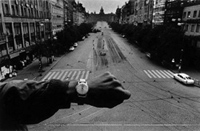
The ostensible point of this photograph, The Urge to See by Josef Koudelka, is that it bears witness to a traumatic historical event, the Soviet invasion of Czechoslovakia in 1968. The arm in the foreground is significant because bears a watch, directly time stamping the place. In the distance tanks are surrounding the parliament building, visible as a silhouette.
Of course, as is appropriate for trauma, rather than injury, there is nothing to see. The real force of the photograph is that all the events are obscene, hidden behind the surface of the image. The boulevard, which should be thronging with people at this hour, is utterly empty of traffic. In this regard, it strongly resembles one of the first photographs ever taken, this early daguerreotype of the streets of Paris.
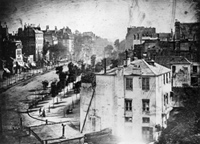
In the case of Daguerre's photograph, the pedestrians, the horses, even the carriages are all present, they've simply vanished into the maw of the photograph, erased by the slow exposure time necessary to capture the image. There are only two human figures present, and neither of them could have known they were being photographed, seeing as the word was yet to be invented. One man, getting his shoes shined, and the almost anamorphic presence of the shoe shine boy, all the action of the street reduced to a puppet-show version of Hegel's master and slave.
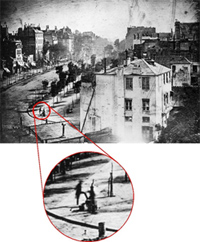
The effect of the comparison, enhanced by the nineteenth century architecture of both streets, and made conscious by the presence of the anoraked arm bearing the watch, is to induce the sensation of time travel. Of course, the appeal of the picture is that it's your arm, and you have the ability to surge backwards and forwards, or at least back and forth, in history. You are holding the camera, and you are looking through it, into the event in which you stand, photographing your arm. The fourth dimension is no longer irreversible, it's just an axis in a cartesian system along which you can stroll. To prove this to yourself, rotate the image 90° counter-clockwise, and imagine that your arm is now a fist raised in protest, clutching a flag. See? Dimensions variable.

Of course, after a certain point along the time axis, people stop looking through their cameras and start looking at their cameras, at the image captured on an LCD screen. That is, they no longer look at the world distorted by a glass lens, they look at it re-synthesized on a plastic sheet. They examine the synthetic image of the event that they can never inhabit, but only see evidence of, to the limit of a certain resolution. As the art historian Geoffrey Batchen has pointed out, this is not an insignificant change. Once documentation completely takes over in this way, the present moment is completely banished. The computer graphics pioneer Alvy Ray Smith once defined 'reality' as a convenient measure of complexity. That's the position we have respective to the LCD screen: we aren't using the glass of the camera to shield us from the event, we never see the event at all. Rather, it exists from the first moment as documentation. It's now the area behind the camera that is frighteningly depopulated.
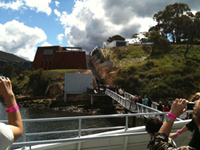
What is this?
These are photographs of the opening of the MONA, an event that (zooming in on the pink wristband) we can confirm took place on Friday, the 21st of January. MONA is an acronym for the Museum of Old and New Art. Cut directly into the rock on the edge of a promontory in Tasmania, it resembles a bunker, or the secret headquarters of a James Bond villain.
The museum is an entirely private endeavour, funded by a statistician, David Walsh, who has perhaps made a hundred million dollars from gambling. With his wealth, and with all the restraint of a Russian Oligarch, he decided to establish a gallery dedicated to his two favourite themes: sex and death.

These are dead foals, and some other mammals, freshly shot to decorate a food platter for MONA's opening night party. To celebrate the completion of his museum, David Walsh invited all the richest and most influential dealers and collectors to his private retreat. He not only offered sushi, he brought in a whole blue fin tuna and a team of sashimi chefs from Japan. He didn't just purchase venison, he slaughtered the deer whole. He said that he did this because he hates the art world, and he wants to teach it a lesson.
The photograph was taken by a friend's camera phone. He was at the party with a fake identity, impersonating a much older, richer man. Many people surreptitiously took pictures with their camera phones throughout the night. There is a complete record of events, but it is as fragmented as the memories spread amongst the guests. My friend sent me these pictures because I asked so many questions about this party.
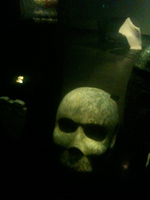
In the fishtanks are said to be pre-Columbian antiquities from South America. The fish around them are supposedly piranhas. At the opening night a Ferrari was rammed into a wall. This was part of the opening, not a result of the limitless supply of champagne and absinthe. By midnight many of the younger, prettier guests were dancing naked, because they felt like it.
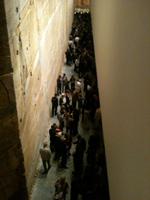
Here, unfortunately, all the guests are clothed. It's earlier on. The dignitaries and celebrities look like tourists lost in a Pharaoh's tomb. Later, they will be dancing, they will be full of caviar and champagne and some of them will be naked. They will be kissing strangers open mouthed. It will feel like a decadent party, like ancient Rome, like something apocalyptic.
At 6:30 in the morning, David Walsh's voice came on over all the speakers on the promontory. Over the speakers left idle from the rock concert earlier, over the alarm tannoy, over the internal address system. He spoke, and his voice resounded like the voice of God. Nobody can remember what it was that he said, because they were all so drunk.
|